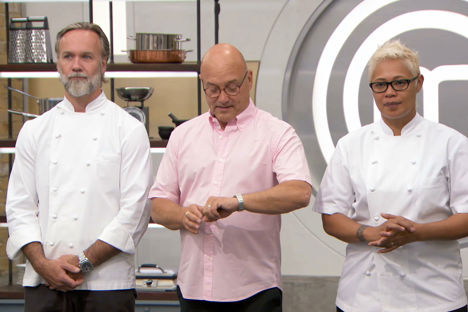
What we learnt from week five of MasterChef: The Professionals 2018
We’re down to the knockout stages of the competition! This week our remaining chefs took on team-based tasks, invention tests and a showstopper challenge. See how they got on.
What we learnt from week five of MasterChef: The Professionals 2018
We’re down to the knockout stages of the competition! This week our remaining chefs took on team-based tasks, invention tests and a showstopper challenge. See how they got on.
Week five signals the true beginning of the competition – many good chefs have fallen by the wayside over the last four weeks, and we’re left with the twelve strongest competitors. The opening rounds always single out the strongest, most confident chefs, but this part of the series tests other intangibles – their leadership, communication skills and ability to work as part of a team.
This week saw our chefs take on an invention test first – Marcus and Monica gave them a huge range of ingredients but took away the sous vide water baths in the kitchen, forcing the competitors to show off their mastery of traditional cooking techniques. Next, they divided into two teams to tackle a three-course meal for maritime charity Trinity House and the Royal College of Physicians. Twelve contestants started the week, but only eight finished it – read on for some of the things we learnt this week.
Braising is an easy, delicious way to cook meat and vegetables – once you’ve got it ticking away, you can leave it happily bubbling away for hours until everything is tender. It pays to check on your braise every now and again though – if you don’t have a pot with a tight-fitting lid, your braise could end up over-reducing and burning. Matthew nearly met disaster with his ox cheeks, but he saved it just in time.
There was a lot of classic French cooking going on in the MasterChef kitchen this week – we saw classics like pomme dauphine, pomme soufflé, and a spectacular poulet en vessie from Matthew, where chicken breast is cooked inside a pig’s bladder. The beauty of modern techniques like sous vide is that you can achieve great, consistent results, but sometimes, there’s nothing quite like proper, old-school, classic cookery.
There are lots of desserts where at some point you combine eggs with a hot liquid – often it involves infusing cream, then combining that cream with eggs. If your cream is too hot, it’ll scramble your cold eggs when the two are combined. The trick is to let your cream cool a little, then temper your eggs by adding a splash of the cream first – this brings the whole egg mixture up to temperature, so the eggs don’t scramble when you mix in the rest of the hot liquid.
The second team conjured up a starter based around a confit piece of sea bream. The idea was to confit and then crisp up the skin, but as Marcus pointed out, that’s almost impossible to do with confit fish. What confit does give you is beautifully soft, flaky flesh – check out our confit guide for more.
Making a cherry mousse in the final round, Elizabeth was unfortunate to split her mousse when she folded her cream into a cherry mixture that was too warm. As a result, the mousse never set, splitting and becoming grainy instead. Check out our guides to see how to do it the right way.


